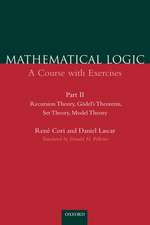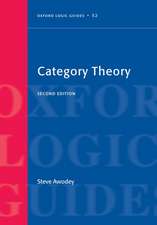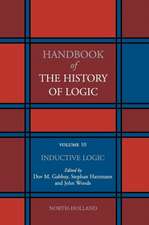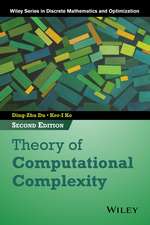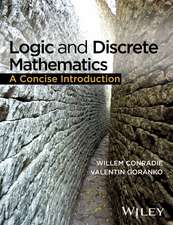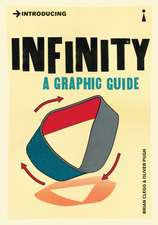Ordered Sets: An Introduction with Connections from Combinatorics to Topology
Autor Bernd Schröderen Limba Engleză Hardback – 19 mai 2016
| Toate formatele și edițiile | Preț | Express |
|---|---|---|
| Paperback (2) | 394.87 lei 6-8 săpt. | |
| Birkhäuser Boston – 5 noi 2012 | 394.87 lei 6-8 săpt. | |
| Springer International Publishing – 26 mai 2018 | 438.65 lei 39-44 zile | |
| Hardback (1) | 508.77 lei 39-44 zile | |
| Springer International Publishing – 19 mai 2016 | 508.77 lei 39-44 zile |
Preț: 508.77 lei
Preț vechi: 628.11 lei
-19% Nou
Puncte Express: 763
Preț estimativ în valută:
97.35€ • 102.19$ • 80.80£
97.35€ • 102.19$ • 80.80£
Carte tipărită la comandă
Livrare economică 07-12 aprilie
Preluare comenzi: 021 569.72.76
Specificații
ISBN-13: 9783319297866
ISBN-10: 3319297864
Pagini: 389
Ilustrații: XVI, 420 p. 53 illus., 10 illus. in color.
Dimensiuni: 155 x 235 x 26 mm
Greutate: 0.95 kg
Ediția:2nd ed. 2016
Editura: Springer International Publishing
Colecția Birkhäuser
Locul publicării:Cham, Switzerland
ISBN-10: 3319297864
Pagini: 389
Ilustrații: XVI, 420 p. 53 illus., 10 illus. in color.
Dimensiuni: 155 x 235 x 26 mm
Greutate: 0.95 kg
Ediția:2nd ed. 2016
Editura: Springer International Publishing
Colecția Birkhäuser
Locul publicării:Cham, Switzerland
Descriere
This work is an introduction to the basic tools of the theory of (partially) ordered sets such as visualization via diagrams, subsets, homomorphisms, important order-theoretical constructions, and classes of ordered sets. Using a thematic approach, the author presents open or recently solved problems to motivate the development of constructions and investigations for new classes of ordered sets.
A wide range of material is presented, from classical results such as Dilworth's, Szpilrajn's and Hashimoto's Theorems to more recent results such as the Li--Milner Structure Theorem. Major topics covered include: chains and antichains, lowest upper and greatest lower bounds, retractions, lattices, the dimension of ordered sets, interval orders, lexicographic sums, products, enumeration, algorithmic approaches and the role of algebraic topology.
Since there are few prerequisites, the text can be used as a focused follow-up or companion to a first proof (set theory and relations) or graph theory class. After working through a comparatively lean core, the reader can choose from a diverse range of topics such as structure theory, enumeration or algorithmic aspects. Also presented are some key topics less customary to discrete mathematics/graph theory, including a concise introduction to homology for graphs, and the presentation of forward checking as a more efficient alternative to the standard backtracking algorithm. The coverage throughout provides a solid foundation upon which research can be started by a mathematically mature reader.
Rich in exercises, illustrations, and open problems, Ordered Sets: An Introduction is an excellent text for undergraduate and graduate students and a good resource for the interested researcher. Readers will discover order theory's role in discrete mathematics as a supplier of ideas as well as an attractive source of applications.
A wide range of material is presented, from classical results such as Dilworth's, Szpilrajn's and Hashimoto's Theorems to more recent results such as the Li--Milner Structure Theorem. Major topics covered include: chains and antichains, lowest upper and greatest lower bounds, retractions, lattices, the dimension of ordered sets, interval orders, lexicographic sums, products, enumeration, algorithmic approaches and the role of algebraic topology.
Since there are few prerequisites, the text can be used as a focused follow-up or companion to a first proof (set theory and relations) or graph theory class. After working through a comparatively lean core, the reader can choose from a diverse range of topics such as structure theory, enumeration or algorithmic aspects. Also presented are some key topics less customary to discrete mathematics/graph theory, including a concise introduction to homology for graphs, and the presentation of forward checking as a more efficient alternative to the standard backtracking algorithm. The coverage throughout provides a solid foundation upon which research can be started by a mathematically mature reader.
Rich in exercises, illustrations, and open problems, Ordered Sets: An Introduction is an excellent text for undergraduate and graduate students and a good resource for the interested researcher. Readers will discover order theory's role in discrete mathematics as a supplier of ideas as well as an attractive source of applications.
Cuprins
Recenzii
“The book is marvelously written with clarity and richness of language and mathematical content being clear hallmarks. … the book is not just a well crafted textbook but also an invaluable companion to the student, reference to current literature, and a source of inspiration for newcomers and established residents of order theory.” (Ittay Weiss, zbMATH 1414.06001, 2019)
"The author has done the field a service by producing an excellent text strong in the presentation of certain topological aspects of the underlying diagrams, e.g., which should serve the developing community and field well and which can be recommended without reservations as one of the volumes which should grace a poseteer's library whether she is interested only or mainly in the theory of these objects or has directed her gaze towards applications. As a sourcebook of ideas and understanding it will make its mark. And deservedly so." —ZENTRALBLATT MATH
"This book is a most successful introduction to the theory of ordered sets. The range of topics covered is wide yet the exposition is self-contained . . . The focus on open problems makes for enthusiastic writing and provides continuity among the diverse topics that are discussed . . . in each chapter the author proves a solid collection of basic results, presents one or more major theorems with detailed and nontrivial proofs, and states without proof one or two other important results. At the end of every chapter is an ample collection of exercises . . . A novel aspect of [the twelfth] chapter is the presentation of much of the material in terms of constraint satisfaction problems." —MATHEMATICAL REVIEWS
"...surprisingly, despite the extremely basic nature of the subject, this monograph has essentially no competition. But fortunately the first entry proves a gem. Undergraduate mathematics and computer science majors will find the first chapters offering background that will serve them well in many courses. The rest of the book, which features many open problems, constitutes an accessible and stimulating invitation to research . . . Highly recommended." —CHOICE
"There are two groups of people who will primarily profit from the book. First, researchers in the field of ordered sets and lattices and related fields like algebra, graphs, and combinatorics. The book provides an excellent look at the field with numerous remarks including historical remarks and open problems. Second, students who are looking for a PhD topic. The author presents the field of ordered sets in an attractive way and the many open problems presented in the book are invaluable. Mathematicians and computer scientists could use the book as a reference book, too...[T]he book is a success, it presents an in depth and up to date carefully written coverage of ordered sets." —SIGACT NEWS
"The author has done the field a service by producing an excellent text strong in the presentation of certain topological aspects of the underlying diagrams, e.g., which should serve the developing community and field well and which can be recommended without reservations as one of the volumes which should grace a poseteer's library whether she is interested only or mainly in the theory of these objects or has directed her gaze towards applications. As a sourcebook of ideas and understanding it will make its mark. And deservedly so." —ZENTRALBLATT MATH
"This book is a most successful introduction to the theory of ordered sets. The range of topics covered is wide yet the exposition is self-contained . . . The focus on open problems makes for enthusiastic writing and provides continuity among the diverse topics that are discussed . . . in each chapter the author proves a solid collection of basic results, presents one or more major theorems with detailed and nontrivial proofs, and states without proof one or two other important results. At the end of every chapter is an ample collection of exercises . . . A novel aspect of [the twelfth] chapter is the presentation of much of the material in terms of constraint satisfaction problems." —MATHEMATICAL REVIEWS
"...surprisingly, despite the extremely basic nature of the subject, this monograph has essentially no competition. But fortunately the first entry proves a gem. Undergraduate mathematics and computer science majors will find the first chapters offering background that will serve them well in many courses. The rest of the book, which features many open problems, constitutes an accessible and stimulating invitation to research . . . Highly recommended." —CHOICE
"There are two groups of people who will primarily profit from the book. First, researchers in the field of ordered sets and lattices and related fields like algebra, graphs, and combinatorics. The book provides an excellent look at the field with numerous remarks including historical remarks and open problems. Second, students who are looking for a PhD topic. The author presents the field of ordered sets in an attractive way and the many open problems presented in the book are invaluable. Mathematicians and computer scientists could use the book as a reference book, too...[T]he book is a success, it presents an in depth and up to date carefully written coverage of ordered sets." —SIGACT NEWS
Notă biografică
Bernd Schröder serves as Chair of the Department of Mathematics at The University of Southern Mississippi. In addition to teaching and service, he has published over 40 papers on subjects including ordered sets, graph theory, analysis, computer science, and engineering education.
Textul de pe ultima copertă
The second edition of this highly praised textbook provides an expanded introduction to the theory of ordered sets and its connections to various subjects. Utilizing a modular presentation, the core material is purposely kept brief, allowing for the benefits of a broad exposure to the subject without the risk of overloading the reader with too much information all at once. The remaining chapters can then be read in almost any order, giving the text a greater depth and flexibility of use. Most topics are introduced by examining how they relate to research problems, some of them still open, allowing for continuity among diverse topics and encouraging readers to explore these problems further with research of their own.
A wide range of material is presented, from classical results such as Dilworth's, Szpilrajn's, and Hashimoto's Theorems to more recent results such as the Li-Milner Structure Theorem. Major topics covered include chains and antichains, lowest upper and greatest lower bounds, retractions, algorithmic approaches, lattices, the dimension of ordered sets, interval orders, lexicographic sums, products, enumeration, and the role of algebraic topology. This new edition shifts the primary focus to finite ordered sets, with results on infinite ordered sets presented toward the end of each chapter whenever possible. Also new are Chapter 6 on graphs and homomorphisms, which serves to separate the fixed clique property from the more fundamental fixed simplex property as well as to discuss the connections and differences between graph homomorphisms and order-preserving maps, and an appendix on discrete Morse functions and their use for the fixed point property for ordered sets.
Rich in examples, diagrams, and exercises, the second edition of Ordered Sets will be an excellent text for undergraduate and graduate students and a valuable resource for interested researchers. It will be especially useful to those looking for an introduction to the theory of ordered sets and its connections to such areas as algebraic topology, analysis, and computer science. PRAISE FOR THE FIRST EDITION
"The author has done the field a service by producing an excellent text strong in the presentation of certain topological aspects of the underlying diagrams, e.g., which should serve the developing community and field well and which can be recommended without reservations as one of the volumes which should grace a poseteer's library whether she is interested only or mainly in the theory of these objects or has directed her gaze towards applications. As a sourcebook of ideas and understanding it will make its mark. And deservedly so." — ZENTRALBLATT MATH
“…A gem. Undergraduate mathematics and computer science majors will find the first chapters offering background that will serve them well in many courses. The rest of the book, which features many open problems, constitutes an accessible and stimulating invitation to research . . . Highly recommended."
— CHOICE
“The author presents the field of ordered sets in an attractive way and the many open problems presented in the book are invaluable...[T]he book is a success, it presents an in depth and up to date carefully written coverage of ordered sets." —SIGACT NEWS
A wide range of material is presented, from classical results such as Dilworth's, Szpilrajn's, and Hashimoto's Theorems to more recent results such as the Li-Milner Structure Theorem. Major topics covered include chains and antichains, lowest upper and greatest lower bounds, retractions, algorithmic approaches, lattices, the dimension of ordered sets, interval orders, lexicographic sums, products, enumeration, and the role of algebraic topology. This new edition shifts the primary focus to finite ordered sets, with results on infinite ordered sets presented toward the end of each chapter whenever possible. Also new are Chapter 6 on graphs and homomorphisms, which serves to separate the fixed clique property from the more fundamental fixed simplex property as well as to discuss the connections and differences between graph homomorphisms and order-preserving maps, and an appendix on discrete Morse functions and their use for the fixed point property for ordered sets.
Rich in examples, diagrams, and exercises, the second edition of Ordered Sets will be an excellent text for undergraduate and graduate students and a valuable resource for interested researchers. It will be especially useful to those looking for an introduction to the theory of ordered sets and its connections to such areas as algebraic topology, analysis, and computer science. PRAISE FOR THE FIRST EDITION
"The author has done the field a service by producing an excellent text strong in the presentation of certain topological aspects of the underlying diagrams, e.g., which should serve the developing community and field well and which can be recommended without reservations as one of the volumes which should grace a poseteer's library whether she is interested only or mainly in the theory of these objects or has directed her gaze towards applications. As a sourcebook of ideas and understanding it will make its mark. And deservedly so." — ZENTRALBLATT MATH
“…A gem. Undergraduate mathematics and computer science majors will find the first chapters offering background that will serve them well in many courses. The rest of the book, which features many open problems, constitutes an accessible and stimulating invitation to research . . . Highly recommended."
— CHOICE
“The author presents the field of ordered sets in an attractive way and the many open problems presented in the book are invaluable...[T]he book is a success, it presents an in depth and up to date carefully written coverage of ordered sets." —SIGACT NEWS
Caracteristici
Presents a wide range of material, from classical to brand new results
Uses a modular presentation in which core material is kept brief, allowing for a broad exposure to the subject without overwhelming readers with too much information all at once
Introduces topics by examining how they related to research problems, providing continuity among diverse topics and encouraging readers to explore these problems with research of their own
Includes supplementary material: sn.pub/extras
Uses a modular presentation in which core material is kept brief, allowing for a broad exposure to the subject without overwhelming readers with too much information all at once
Introduces topics by examining how they related to research problems, providing continuity among diverse topics and encouraging readers to explore these problems with research of their own
Includes supplementary material: sn.pub/extras




